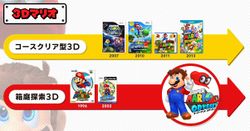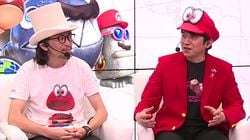User:Shokora/Odyssey development
Development
Background

When asked about "coming home" to the Super Mario 64 and Super Mario Sunshine style of gameplay, Shigeru Miyamoto explained that when he was developing Super Mario 64 with Yoshiaki Koizumi, they realized that the title would be more directed towards the "core gamer", rather than the casual, pick-up-and-go gamer.[1] After Super Mario Sunshine, their focus re-shifted to more accessible, casual gamers, hence encouraging them to make Super Mario Galaxy with more progression-oriented gameplay corridors.
Then in recent years, we made Super Mario 3D World and even though that's a 3D game, it's a little more accessible to everybody. [...] So when we thought about making a Mario for Switch, we wanted to make it [...] something a little bit more on the core side, that people who like action games can really get into.
As Super Mario Odyssey was developed alongside the Switch hardware, Yoshiaki Koizumi encouraged the game's developers to share their requirements and suggestions with the hardware development team.[2] This directly led to the inclusion of the two motion-sensitive controllers and the HD rumble feature on the Nintendo Switch hardware, which became a prominent part of Super Mario Odyssey gameplay.
Early ideas and prototypes
Development for Super Mario Odyssey began right after Super Mario 3D World was released in late 2013.[3] Miyamoto sought more senior developers and staff teams who had been involved in past 3D Mario titles, in order to really "go back to the roots" of Super Mario Sunshine and Super Mario 64.[1] As a result, Yoshiaki Koizumi was made the game's producer, and Super Mario 3D World director Kenta Motokura again took on the role of director. Miyamoto remained with a consultative role throughout development, and although he contributed a lot of feedback, he was also very accepting of the development team's ideas.[4] Motokura revealed that early stages of development involved creating a "huge" amount of gameplay prototypes with numerous ideas, and the capture ability was one of them.[5]
[The capture ability] was just one of the ideas that came up, but we worked on it for two or three days, and it just instantly turned into something that was really fun, and we decided [that it should be] the center of this game.
Many of the other different prototype ideas were still included, providing for the diversity in game mechanics throughout the game's stages, known as "kingdoms". These "fully realized worlds" were said to have been inspired by the Japanese hakoniwa box gardens, that bring rich landscapes to life in a miniaturized form.[6] The size of these worlds were often adjusted to ensure that the player is regularly discovering an engaging action to perform.[2] This was also intended to allow handheld players to still accomplish a Power Moon mission, even if they have only a few minutes to play.[7]
[research]
Super Mario Odyssey's theme is highly focused on "surprises" and "travel", and the developers incorporated many of their travel experiences around the world.[5] For instance, elements of the Sand Kingdom was derived from Kenta Motokura's experiences during a trip to Mexico, and the Luncheon Kingdom's food aesthetics was inspired by Italy and other European countries.[8]

The developers recognized that when traveling to foreign countries, something that really has an impact is the different currencies. Therefore, they wanted to have Mario collect and use different Regional Coins in each kingdom. Since the player travels outside of the Mushroom Kingdom, the diverse art-style between all the different kingdoms aimed to recreate the feelings of surprise and discovery when visiting foreign lands. It was also noted that a lot of time was spent in getting the right balance between familiar Mario concepts, and completely new ones.[5]
An example was the realistic T-Rex that is able to be captured by Mario. The developers looked back for inspiration from familiar Super Mario World elements in Dinosaur Land, although they wanted to use a design that was "unseen" in a Mario game.[5] Familiar gameplay elements include the "8-bit" side-scrolling areas of the kingdoms, reminiscent to Super Mario Bros. in which progress is more "confined" and "precise". This was intended to be an engaging contrast to the 3D sandbox environments.
The developers knew they wanted to have a city environment in the game that would resonate with players. As Donkey Kong-inspired elements in the city came about, Pauline's presence in the series inspired the team to have her be the mayor of New Donk City. Some character development for Pauline was required in her transition from a damsel in distress to a major character, and it was decided that she would have an interest in jazz.[9] This led to the composition of the game's theme song shown in the E3 2017 trailer, titled Jump Up, Super Star!, which was made to give the game energy and help get the audience excited.[5]
To develop the game's camera system, the team looked at previous 3D Mario games. Miyamoto discussed how the 3D camera in Super Mario 64 worked very well, as it had the joystick as well as the C buttons to adjust the automatic camera. Super Mario Sunshine had the C stick in order to control the camera freely, although they received feedback that the camera control was "a little bit difficult". With later 3D titles such as Super Mario Galaxy, the minimal control of the camera also attracted some negative feedback. Miyamoto added that it's "very difficult to find the right balance".[1]
With Super Mario Odyssey, we made sure that the camera controls are really really smooth and easy to use, and the Switch controllers can really serve to that. [We] really made a sandbox-style game that's really easy and feels good to control.
References
- ^ a b c NinEverything. (January 13, 2017). Miyamoto on Super Mario Odyssey - Nintendo Treehouse Live with Nintendo Switch. YouTube. Retrieved January 15, 2017.
- ^ a b http://metro.co.uk/2017/06/19/super-mario-odyssey-interview-with-yoshiaki-koizumi-and-kenta-motokura-please-look-forward-to-it-6718082/
- ^ I played 30 minutes of Super Mario Odyssey and it sure is impressive. Kotaku. Retrieved September 24, 2017.
- ^ How Shigeru Miyamoto Influenced Mario Odyssey’s Development. Gameinformer. Retrieved September 27, 2017.
- ^ a b c d e Mario Party Legacy. (June 19, 2017). 2 Hours of Super Mario Odyssey Gameplay (E3 2017, Direct). YouTube. Retrieved September 24, 2017.
- ^ What's in a Box?. Nintendo Treehouse Log, Tumblr. Retrieved September 26, 2017.
- ^ Nintendo Finally Answers: Is Mario Human?. Vice. Retrieved September 26, 2017
- ^ Nintendo UK. (August 23, 2017). Super Mario Odyssey - Luncheon Kingdom showcase with Yoshiaki Koizumi (Nintendo Switch). YouTube. Retrieved September 24, 2017.
- ^ Hi, I’m Mr. Koizumi, Producer of Super Mario Odyssey. AMA!. Reddit. Retrieved September 27, 2017.